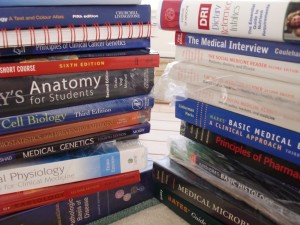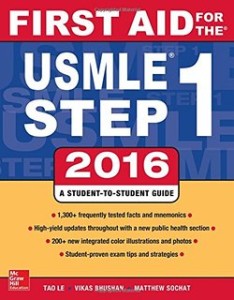First Aid for the USMLE Step 1 2016
Table of Contents
Doctors save lives. Doctors will always have job security. Doctors enjoy a fast-paced, challenging, and meaningful career. But to get started in this rewarding and important field, first you must first successfully make it through medical school… and that’s no small feat.
Taking the USMLE
“First Aid for the USMLE Step 1”, by Tao Le and Vikas Bhushan, can be considered the Holy Bible of preparing for Step 1 of the USMLE (United States Medical Licensing Examination). Whatever your reason for applying to medical school, you’ve surely come to see by now that the journey is even more difficult than you had anticipated. Especially in the beginning of your studies, when students are weeded out left, right, and center, you will need to apply yourself fully if you wish to proceed.
Even if you’re the type of student who could rely on studying the night before an exam all throughout high school and college, medical school is a whole different ballgame. Not only are your classroom requirements of the utmost importance, but you are also contending with the USMLE if you wish to see the day when you can sign that “MD” after your name. (Nurses, on the other hand, apply to nursing programs through taking the TEAS exam.)
Endless hours of studying and stress-induced migraines are only the beginning… there will be weeks and months when it feels like your entire life revolves around medical school, and your life outside will just have to take a backseat. It can be enormously frustrating having to miss out on loved ones’ birthdays, nights out with friends, and even just lazy Sundays lounging about the house in pajamas. For medical students, hard work and studying diligently are top priority, since the requirements are fierce and the competition even fiercer.
First Aid for the USMLE Step 1 2016
The USMLE is the three-part test for receiving a license to practice medicine, for graduates of American and Canadian medical schools. It tests the ability to deliver effective and safe patient care through the application of necessary principles and knowledge.
Each section of the USMLE builds upon the previous sections, and any M.D. physician may only apply for a license to practice medicine once all three steps of the exam have been passed.
First Aid for the USMLE 2016 Step 1 contains over 750 pages jam-packed with everything you need to know for the exam: tips on how to make your studying as efficient as possible, a guide to top-rated study resources (including mobile apps), and more than 1,250 crucial topics with 1,000+ full color diagrams and photos to visually demonstrate these concepts.
“First Aid” was originally published in 1995, and since then has undergone several editions and been updated multiple times based on thousands of students’ feedback. Furthermore, the corresponding website, www.firstaidteam.com, is corrected and updated in real-time, making it the perfect companion to the book.
As compared with older editions of this book, there are plenty of changes to make this upgrade worthwhile. If you are someone who flips through the book as often as I do, the stronger binding will make a huge and noticeable difference. The last thing you need is your study book coming apart at the seams. In addition to new information being added, I’ve also noticed that pre-existing information has often been clarified to make reading an easier and smoother process. Furthermore, the Kindle edition of this book has finally been fixed and is almost an exact copy of the print edition, which is perfect for studying on-to-go (as I find myself doing more often than not).
The authors clearly know what they are talking about, across the board. Bhushan practices diagnostic radiology from his home-base in Los Angeles, while Le is Assistant Clinical Professor of Pediatrics in the Division of Allergy and Immunology at the University of Louisville (and is also affiliated with the Division of Allergy and Immunology at The Johns Hopkins University School of Medicine).
Step 1 USMLE Test
Medical students generally take the step 1 exam at the end of their second year of medical school, upon completion of the Basic Sciences portion of their curriculum. This exam covers biochemistry, microbiology, physiology, anatomy, pathology, behavioral sciences, pharmacology, and interdisciplinary topics (including genetics, aging, and nutrition).
Step 1 is a computerized, 8-hour exam comprised of 308 multiple choice questions. The test is divided into seven blocks of 44 questions each, with one hour allotted per block and the remaining hour given as a break.
An optional fifteen minute tutorial about how to use the exam’s computer program may be taken at the exam’s start, and if taken, the time is deducted from the break hour. If there is any time left over at the end of the eight hours, a quality assurance survey is given.
As of January 1, 2014, the passing score was raised to 192 (from a 188). The score from step 1 is typically considered one of the most important criteria in applying to various residency programs.
Step 1 if viewed as so crucial, since failed attempts are permanently recorded and passing attempts prevent a student from retaking it to achieve a higher score. The student is essentially granted one opportunity to determine the future residencies which he or she will be considered for.
Steps 2 and 3 of USMLE Exam
Relax, tiger, you have a ways to go until it comes time for the remaining two steps of the USMLE. Oh, that’s right – we’re medical students. We don’t relax about anything and are constantly planning ahead for future worries.
USMLE Step 2 is taken during the fourth year of medical school, and divided into two separate exams: the Step 2 CK and Step 2 CS. These two sections combined assess students’ ability to apply their understanding and knowledge to patient care under supervision. The Step 2 CK is a 9 hour, multiple-choice exam which tests subjects including psychiatry, pediatrics, surgery, and obstetrics & gynecology. Meanwhile, the Step 2 CS tests clinical skills through simulated patient interactions. There are actors who appear as the “patients”, and each test taker must interact with 12 standardized patients (SPs). Per each patient, the tester is granted 15 minutes for history taking and clinical examination, and an additional 10 minutes to write his or her findings, initial differential diagnosis list, and a list of initial tests in the form of a patient note. The Step 2 CS was first administered in 2004 (previously, a similar exam called the Clinical Skills Assessment was used) and it is only offered in five cities throughout the country: Philadelphia, Chicago, Atlanta, Houston, and Los Angeles.
USMLE Step 3 is generally taken at the completion of the first year of residency. Like Step 2, it is divided into two parts. The first day of testing for Step 3 consists of 256 multiple-choice questions, while the second day includes further multiple-choice items as well as 13 “clinical case simulations” where students are granted 10 or 20 minutes to enter orders for medications and/or investigations.
Whatever field you enter, whatever you choose to study: standardized testing is often an inevitable part of your studies. Applying to graduate school programs will often require either the GRE or, for business schools, the GMAT.




No comments yet.